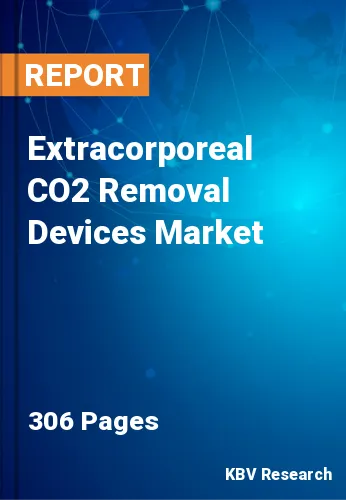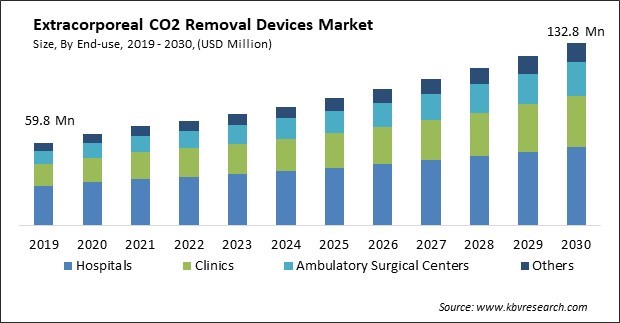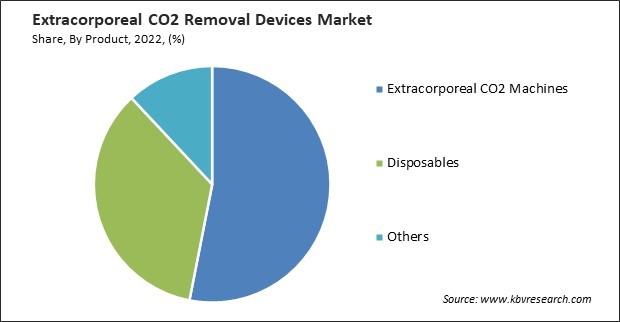
The Global Extracorporeal CO2 Removal Devices Market size is expected to reach $132.8 million by 2030, rising at a market growth of 7.3% CAGR during the forecast period.
The increase in the prevalence of respiratory diseases represents a significant global health challenge. Therefore, the acute respiratory distress syndrome (ARDS) segment acquired $14.5 million revenue in the market in 2022. Several interconnected factors contribute to this concerning trend. Firstly, demographic shifts, such as an aging population, have increased susceptibility to respiratory conditions. Age-related changes in lung function and weakened immune systems make older adults more vulnerable to respiratory diseases like chronic obstructive pulmonary disease (COPD) and pneumonia. Some of the factors impacting the market are the latest technological advancements in extracorporeal removal devices, increase in the population of aged people and high initial cost in the adoption of devices.

Smaller ECCO2R devices are less invasive and more comfortable for patients. They often require smaller vascular access, reducing the potential for complications. Patients can experience increased mobility and comfort as they are not tethered to large, immobile equipment, enhancing their overall quality of life during treatment. Advances in membrane technology have played an essential role in enhancing the effectiveness and efficacy of extracorporeal CO2 removal devices. They selectively allow CO2 to diffuse through while retaining essential blood components, such as red blood cells and proteins. This selectivity minimizes the risk of hemolysis and other blood-related complications. Therefore, the demand for extracorporeal CO2 removal devices will be higher. Additionally, the geriatric population places a significant emphasis on maintaining their quality of life. ECCO2R devices align with this goal by offering less invasive and gentler respiratory support. They can help older patients maintain their independence and overall well-being. Technological advancements in ECCO2R have led to the development of more user-friendly and portable devices. As the benefits become more widely recognized, ECCO2R is increasingly integrated into the treatment plans for older adults. All these factors will help boost the demand for extracorporeal CO2 removal devices in the coming years.
Furthermore, the use and advancement of extracorporeal CO2 removal (ECCO2R) devices and related respiratory support technologies were significantly influenced by the COVID-19 pandemic. COVID-19 led to severe respiratory distress and acute respiratory distress syndrome (ARDS) in some patients. Hospitals and healthcare systems faced a surge in critically ill patients requiring respiratory support. ECCO2R devices were considered to provide additional respiratory support in situations where traditional mechanical ventilation alone might not suffice. These guidelines were designed to help healthcare providers make informed decisions about when and how to use extracorporeal CO2 removal devices to manage COVID-19-related respiratory distress. Therefore, the COVID-19 had a positive impact on the extracorporeal CO2 removal devices market.
However, one significant constraint to adopting extracorporeal CO2 removal devices is the high initial costs associated with acquiring and setting up these systems. ECCO2R devices are sophisticated medical equipment with complex components, including specialized gas exchange membranes, blood pumps, monitors, and control systems. The manufacturing and assembly of these components drive up the initial equipment costs. ECCO2R devices must meet stringent quality and safety standards to guarantee patient safety and compliance with regulatory requirements. Manufacturers must invest in regulatory compliance activities, such as obtaining approvals and certifications, which can be costly and time-consuming. As ECCO2R technology evolves, healthcare facilities may need to upgrade their equipment to maintain compatibility with the latest advancements and safety standards. Owing to these factors, the demand for extracorporeal CO2 removal devices is expected to decrease.
On the basis of application, the extracorporeal CO2 removal devices market is divided into acute respiratory distress syndrome (ARDS), chronic obstructive pulmonary disease (COPD), bridge to lung transplant, and others. In 2022, the acute respiratory distress syndrome (ARDS) segment acquired a substantial revenue share in the extracorporeal CO2 removal devices market. The increasing awareness of ARDS and its early detection have led to more patients being diagnosed and treated, creating a greater demand for extracorporeal CO2 removal devices tailored to ARDS management. As a result, healthcare providers have become more confident in incorporating ECCO2R into their ARDS treatment protocols. Therefore, the segment is expected to proliferate in the coming years.
On the basis of end-use, the extracorporeal CO2 removal devices market is segmented into hospitals, ambulatory surgical centers, clinics, and others. The hospitals segment recorded the highest revenue share in the extracorporeal CO2 removal devices market in 2022. Hospitals, especially those with specialized intensive care units (ICUs) and respiratory care facilities, are equipped to manage the most critically ill patients. Moreover, hospitals typically have multidisciplinary teams of healthcare professionals, including pulmonologists, intensivists, respiratory therapists, and perfusionists, who collaborate to manage patients with complex respiratory needs. This expertise is essential for the safe and effective use of ECCO2R devices. As a result, the segment is expected to rise rapidly in the coming years.
Based on product, the extracorporeal CO2 removal devices market is segmented into extracorporeal CO2 machines, disposables, and others. In 2022, the disposables segment garnered a significant revenue share in the extracorporeal CO2 removal devices market. One of the primary drivers of the growth in the disposables segment is the increasing adoption of ECCO2R as a complementary therapy for patients with respiratory failure. As the application of ECCO2R expands to a broader range of clinical scenarios, the demand for disposables needed to perform these procedures has risen significantly.

By access, the extracorporeal CO2 removal devices market is bifurcated into venovenous and arteriovenous. In 2022, the venovenous segment witnessed a considerable growth in the extracorporeal CO2 removal devices market. Clinical evidence and research studies have supported the efficacy of venovenous devices in various patient populations. Positive outcomes and reduced complications in patients with severe respiratory failure have encouraged healthcare providers to consider venovenous devices as a viable treatment option. Moreover, advancements in ECCO2R technology have made venovenous devices in ECCO2R more accessible and user-friendly. These devices are designed with ease of use in mind, allowing healthcare providers to quickly implement and manage therapy, even in high-stress clinical settings. This simplicity has led to broader adoption among healthcare institutions and practitioners. Owing to these factors, the demand for extracorporeal CO2 removal devices in the segment is expected to rise in the future.
| Report Attribute | Details |
|---|---|
| Market size value in 2022 | USD 76.3 Million |
| Market size forecast in 2030 | USD 132.8 Million |
| Base Year | 2022 |
| Historical Period | 2019 to 2021 |
| Forecast Period | 2023 to 2030 |
| Revenue Growth Rate | CAGR of 7.3% from 2023 to 2030 |
| Number of Pages | 306 |
| Number of Table | 448 |
| Report coverage | Market Trends, Revenue Estimation and Forecast, Segmentation Analysis, Regional and Country Breakdown, Companies Strategic Developments, Company Profiling |
| Segments covered | Product, Access, Application, End-use, Region |
| Country scope | US, Canada, Mexico, Germany, UK, France, Russia, Spain, Italy, China, Japan, India, South Korea, Singapore, Malaysia, Brazil, Argentina, UAE, Saudi Arabia, South Africa, Nigeria |
| Growth Drivers |
|
| Restraints |
|
By region, the extracorporeal CO2 removal devices market is divided into North America, Europe, Asia Pacific, and LAMEA. The North America segment witnessed the largest revenue share in the extracorporeal CO2 removal devices market in 2022. The North American healthcare system's willingness to embrace and integrate innovative technologies plays a pivotal role in ECCO2R adoption. Hospitals and healthcare facilities in the region are well-equipped to invest in and implement ECCO2R devices, ensuring access to this life-saving therapy for patients in need. Clinical research and trials in North America have further contributed to the growth of ECCO2R in this segment. Therefore, the demand for extracorporeal CO2 removal devices will increase in the coming years in the North America segment.
Free Valuable Insights: Global Extracorporeal CO2 Removal Devices Market size to reach USD 132.8 Million by 2030
The market research report covers the analysis of key stake holders of the market. Key companies profiled in the report include Medtronic PLC, Getinge AB, Fresenius Medical Care AG & Co. KGaA , Medica S.P.A., Aferetica srl, LivaNova PLC, ESTOR S.P.A., X-COR Therapeutics
By Application
By End-Use
By Product
By Access
By Geography
This Market size is expected to reach $132.8 million by 2030.
Prevalence of respiratory diseases worldwide are driving the Market in coming years, however, High initial cost in the adoption of devices restraints the growth of the Market.
Medtronic PLC, Getinge AB, Fresenius Medical Care AG & Co. KGaA , Medica S.P.A., Aferetica srl, LivaNova PLC, ESTOR S.P.A., X-COR Therapeutics
The expected CAGR of this Market is 7.3% from 2023 to 2030.
The Extracorporeal CO2 Machines segment acquired maximum revenue in the Market, By Product in 2022 thereby, achieving a market value of $68.5 million by 2030.
The North America region dominated the Market, By Region in 2022, and would continue to be a dominant market till 2030; thereby, achieving a market value of $48.9 million by 2030.
Our team of dedicated experts can provide you with attractive expansion opportunities for your business.
